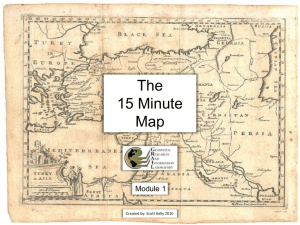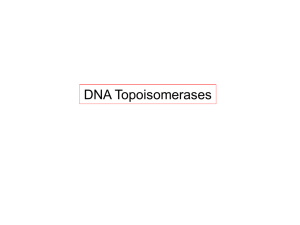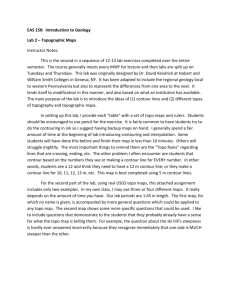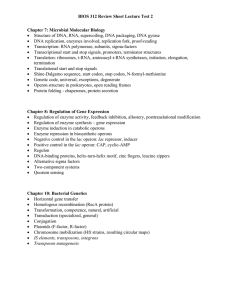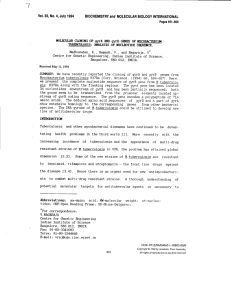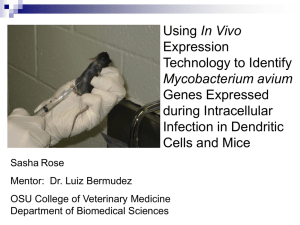mic.sgmjournals.org
advertisement
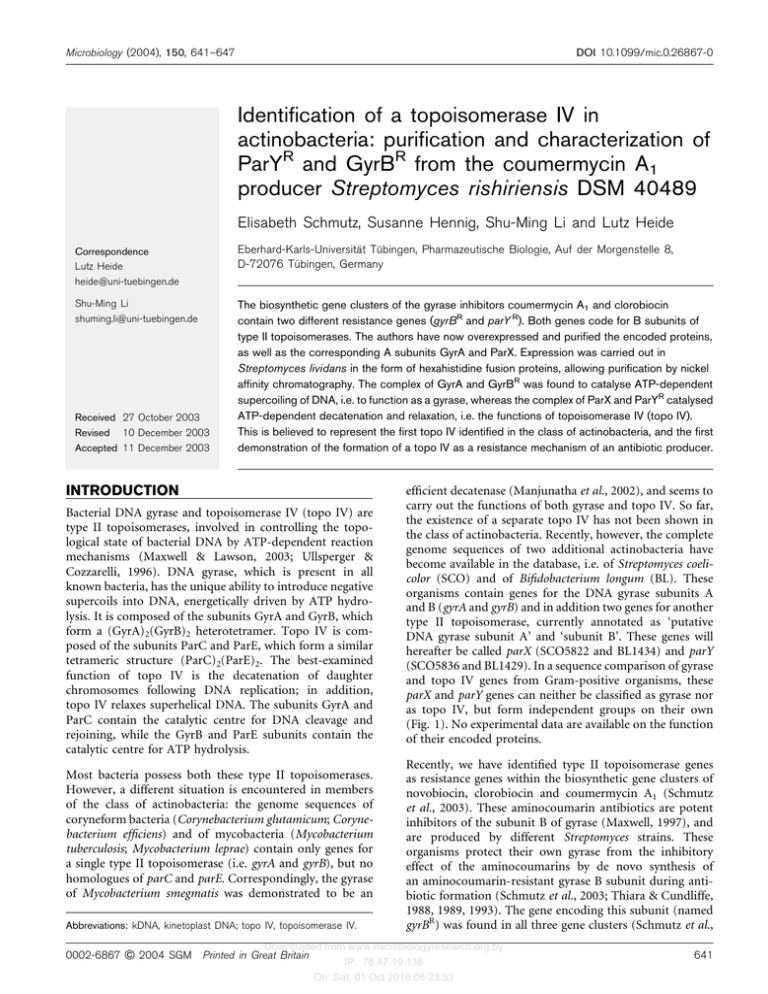
Microbiology (2004), 150, 641–647 DOI 10.1099/mic.0.26867-0 Identification of a topoisomerase IV in actinobacteria: purification and characterization of ParYR and GyrBR from the coumermycin A1 producer Streptomyces rishiriensis DSM 40489 Elisabeth Schmutz, Susanne Hennig, Shu-Ming Li and Lutz Heide Eberhard-Karls-Universität Tübingen, Pharmazeutische Biologie, Auf der Morgenstelle 8, D-72076 Tübingen, Germany Correspondence Lutz Heide heide@uni-tuebingen.de Shu-Ming Li shuming.li@uni-tuebingen.de Received 27 October 2003 Revised 10 December 2003 Accepted 11 December 2003 The biosynthetic gene clusters of the gyrase inhibitors coumermycin A1 and clorobiocin contain two different resistance genes (gyrBR and parY R). Both genes code for B subunits of type II topoisomerases. The authors have now overexpressed and purified the encoded proteins, as well as the corresponding A subunits GyrA and ParX. Expression was carried out in Streptomyces lividans in the form of hexahistidine fusion proteins, allowing purification by nickel affinity chromatography. The complex of GyrA and GyrBR was found to catalyse ATP-dependent supercoiling of DNA, i.e. to function as a gyrase, whereas the complex of ParX and ParYR catalysed ATP-dependent decatenation and relaxation, i.e. the functions of topoisomerase IV (topo IV). This is believed to represent the first topo IV identified in the class of actinobacteria, and the first demonstration of the formation of a topo IV as a resistance mechanism of an antibiotic producer. INTRODUCTION Bacterial DNA gyrase and topoisomerase IV (topo IV) are type II topoisomerases, involved in controlling the topological state of bacterial DNA by ATP-dependent reaction mechanisms (Maxwell & Lawson, 2003; Ullsperger & Cozzarelli, 1996). DNA gyrase, which is present in all known bacteria, has the unique ability to introduce negative supercoils into DNA, energetically driven by ATP hydrolysis. It is composed of the subunits GyrA and GyrB, which form a (GyrA)2(GyrB)2 heterotetramer. Topo IV is composed of the subunits ParC and ParE, which form a similar tetrameric structure (ParC)2(ParE)2. The best-examined function of topo IV is the decatenation of daughter chromosomes following DNA replication; in addition, topo IV relaxes superhelical DNA. The subunits GyrA and ParC contain the catalytic centre for DNA cleavage and rejoining, while the GyrB and ParE subunits contain the catalytic centre for ATP hydrolysis. Most bacteria possess both these type II topoisomerases. However, a different situation is encountered in members of the class of actinobacteria: the genome sequences of coryneform bacteria (Corynebacterium glutamicum; Corynebacterium efficiens) and of mycobacteria (Mycobacterium tuberculosis; Mycobacterium leprae) contain only genes for a single type II topoisomerase (i.e. gyrA and gyrB), but no homologues of parC and parE. Correspondingly, the gyrase of Mycobacterium smegmatis was demonstrated to be an Abbreviations: kDNA, kinetoplast DNA; topo IV, topoisomerase IV. 0002-6867 G 2004 SGM efficient decatenase (Manjunatha et al., 2002), and seems to carry out the functions of both gyrase and topo IV. So far, the existence of a separate topo IV has not been shown in the class of actinobacteria. Recently, however, the complete genome sequences of two additional actinobacteria have become available in the database, i.e. of Streptomyces coelicolor (SCO) and of Bifidobacterium longum (BL). These organisms contain genes for the DNA gyrase subunits A and B (gyrA and gyrB) and in addition two genes for another type II topoisomerase, currently annotated as ‘putative DNA gyrase subunit A’ and ‘subunit B’. These genes will hereafter be called parX (SCO5822 and BL1434) and parY (SCO5836 and BL1429). In a sequence comparison of gyrase and topo IV genes from Gram-positive organisms, these parX and parY genes can neither be classified as gyrase nor as topo IV, but form independent groups on their own (Fig. 1). No experimental data are available on the function of their encoded proteins. Recently, we have identified type II topoisomerase genes as resistance genes within the biosynthetic gene clusters of novobiocin, clorobiocin and coumermycin A1 (Schmutz et al., 2003). These aminocoumarin antibiotics are potent inhibitors of the subunit B of gyrase (Maxwell, 1997), and are produced by different Streptomyces strains. These organisms protect their own gyrase from the inhibitory effect of the aminocoumarins by de novo synthesis of an aminocoumarin-resistant gyrase B subunit during antibiotic formation (Schmutz et al., 2003; Thiara & Cundliffe, 1988, 1989, 1993). The gene encoding this subunit (named gyrBR) was found in all three gene clusters (Schmutz et al., Downloaded from www.microbiologyresearch.org by IP: 78.47.19.138 On: Sat, 01 Oct 2016 08:23:53 Printed in Great Britain 641 E. Schmutz and others Fig. 1. Phylogenetic trees based on sequence similarities of the genes encoding the B and A subunits of type II topoisomerases in Gram-positive bacteria. The phylogeny was constructed using DNASIS for Windows, version 2 (Hitachi) scoring with a gap penalty of 5?0, a K-tuple of 2?0, a fixed gap penalty of 10?0 and a floating gap penalty of 10?0. The number of top diagonals and window size were both set at 5. Bacterial strains are: S. ris., Streptomyces rishiriensis; S. coe., Streptomyces coelicolor; B. lon., Bifidobacterium longum; B. sub., Bacillus subtilis; S. aur., Staphylococcus aureus; M. tub., Mycobacterium tuberculosis; C. glu., Corynebacterium glutamicum; C. per., Clostridium perfringens (cited from Schmutz et al., 2003). 2003). Interestingly, the biosynthetic gene clusters for clorobiocin and coumermycin A1 contained an additional resistance gene (named parYR) which showed high sequence similarity to parY of S. coelicolor (Fig. 1). Upon expression in Streptomyces lividans, both gyrBR and parYR conferred resistance to aminocoumarin antibiotics. In the present study, we have investigated the function of GyrBR and ParYR from the coumermycin A1 producer Streptomyces rishiriensis DSM 40489. Both proteins were overexpressed and then purified by nickel affinity chromatography. After the additional purification of the GyrA and ParX subunits, we assembled the active heterotetrameric (GyrA)2(GyrBR)2 and (ParX)2(ParYR)2 topoisomerases in vitro and investigated their supercoiling, decatenation and relaxation activity. (ParX)2(ParYR)2 was found to have a pronounced decatenating activity and is believed to represent the first topo IV identified in actinobacteria. METHODS Bacterial strains, plasmids and culture conditions. For standard cloning procedures Escherichia coli XL1 Blue MRF9 (Stratagene) and standard protocols as described by Sambrook & Russell (2001) were used. S. lividans TK23 (Kieser et al., 2000) was used as host strain for the isolation of the Streptomyces vector pGM9 (Muth et al., 1989) and was grown in YMG medium (Kieser et al., 2000) at 28 uC for 2–3 days. For preparation of genomic DNA from S. coelicolor, YMG medium was used. Protoplast preparation and transformation of S. lividans T7 (Heinzelmann et al., 2001) for protein expression was carried out according to standard methods (Kieser et al., 2000). E. coli transformants with pET-24a(+) or pGM9 fusion plasmids were selected with kanamycin (50 mg ml21); transformants with pRSET B were selected with carbenicillin (50 mg ml21). For selection of transformants of S. lividans T7, 642 kanamycin (50 mg ml21) was used. Transformants of S. lividans TK24 with pUWL201 expression constructs (Schmutz et al., 2003) were selected with thiostrepton (50 mg ml21). PCR amplification and cloning of topoisomerase genes. The primers used for PCR amplification of the topoisomerase genes are listed in Table 1. gyrBR and parYR were amplified from the cosmid 4-2H described previously (Schmutz et al., 2003). For amplification of the S. coelicolor genes gyrA and parX genomic DNA was used as template. Two different programmes for the amplification were used. For gyrBR, parYR and gyrA the conditions were 1 cycle at 95 uC (5 min), followed by 30 cycles at 95 uC (90 s), 60 uC (90 s) and 72 uC (5 min), and finally 1 cycle at 72 uC (10 min). parX was amplified by denaturation at 96 uC (5 min), followed by 30 cycles at 96 uC (2 min) and 72 uC (6 min), and finally 1 cycle at 72 uC (10 min). Each 100 ml volume of reaction mixture contained about 100 ng template cosmid DNA or 2–5 mg genomic DNA, 20 pmol of each primer, 0?2 mM dNTPs (each, final concentration), Pfu DNA polymerase reaction buffer (2 mM MgSO4, final concentration), 5 % (v/v) DMSO, and 3 units of Pfu DNA polymerase (Promega). The PCR products were digested with the restriction enzymes given in Table 1 and ligated into pRSET B (Invitrogen) (resulting in pRSET B-gyrBR, pRSET B-parYR and pRSET B-gyrA, respectively) or pET24a(+) (Novagen) (resulting in pET-24a-parX). To obtain plasmids replicating in Streptomyces, the pRSET B derivatives pRSET B-gyrBR, pRSET B-parYR and pRSET B-gyrA were digested with HindIII and fused with HindIII-digested pGM9. The construct pET-24a-parX was linearized with BglII and fused with BglII-digested pGM9. Complementation of gyrB and parE temperature-sensitive mutants of E. coli. The E. coli strains N4177 (Menzel & Gellert, 1983) and W3110parE10 (Kato et al., 1990) contain either gyrB or parE with a mutation repressing the function of the resulting proteins at high temperature. Both strains were transformed either with pRSET B-gyrBR or with pRSET B-parYR. Transformed cells were grown on LB agar plates (Sambrook & Russell, 2001) containing carbenicillin (50 mg ml21) and IPTG (0?5 mM). As a positive control pAG111 containing gyrB from E. coli (Hallett et al., 1990) transformed into strain N4177 was used. Cells transformed with pAG111 Downloaded from www.microbiologyresearch.org by IP: 78.47.19.138 On: Sat, 01 Oct 2016 08:23:53 Microbiology 150 Topoisomerase IV in actinobacteria Table 1. Nucleotide sequences of primers used for PCR Introduced restriction sites are underlined and the respective restriction enzymes are given. Primer Nucleotide sequence (5§–3§) Enzyme gyrBC-1 gyrBC-2 parY-1 parY-2 gyrA-4 gyrA-5 parX-1 parX-2 GCCCGAAAGAGCTCGAGTGTGACTAC CGGTGTCCAAGCTTAGATGTCGAGGA AGGAGAGCACTCGAGGAGTACATTCC AGATCCGCGACAGAAGCTTGCTCAGA CAGGAAAGATCTTCACCAGCAATGAC ACTCTCTAAGCTTGCTACTCGGCCGA AGCCGGCACATATGGCCCGCCGTAGTACGAAGAC GACAGAAGCTTGACCGGGCCCGCCACCACCGAC XhoI HindIII XhoI HindIII BglII HindIII HindIII NdeI were grown on LB agar plates supplemented with carbenicillin (50 mg ml21). One set of plates was incubated at 30 uC overnight, and the other was incubated at 42 uC overnight. Complementation was determined by the ability of the transformants to grow at 42 uC. Protein expression and purification. S. lividans T7 strains harbouring the expression constructs were cultured in YEME medium (Kieser et al., 2000) supplemented with kanamycin (10 mg ml21) for 2 days at 28 uC in baffled flasks. Each flask containing 200 ml YEME medium, supplemented with kanamycin (10 mg ml21) and thiostrepton (25 mg ml21), was inoculated with 4 ml of the preculture. After 24 h cultivation at 28 uC (170 r.p.m. in baffled flasks with steel springs) cells were harvested by centrifugation (5000 g, 4 uC, 10 min) and frozen overnight at 270 uC. For lysis the cells were thawed and resuspended in 1 ml lysis buffer (50 mM NaH2PO4, pH 8?0, 300 mM NaCl, 8 mg lysozyme ml21) per g (wet wt) and incubated on ice for 30 min. Cells were broken by sonication (Branson Sonifier 250) for 10 min in 2 min intervals. The lysate was cleared by centrifugation (17 000 g, 4 uC, 30 min). The His-tagged proteins were purified by nickel affinity chromatography by using Ni-nitrilotriacetic acid resin (Qiagen). Some changes to the manufacturer’s standard protocol were necessary in the washing procedure to obtain nearly homogeneous protein fractions. The imidazole concentration in the washing buffer was increased to 30–40 mM, and in the case of GyrBR, urea (2 M) was added to remove traces of GyrA subunit. After elution of the recombinant proteins with 250 mM imidazole, the buffer was exchanged by gel filtration on Sephadex G-25 NAP-10 columns (Amersham Biosciences). The storage buffer contained 50 mM KH2PO4, pH 7?5, 1 mM DTT, 0?2 mM EDTA and 50 % (v/v) glycerol. Refolding of denatured GyrBR protein was achieved by incubation overnight in storage buffer at 4 uC before storage at 220 uC. The collected fractions were analysed by SDS-PAGE according to the method of Laemmli (1970) in 10 % gels. DNA gyrase and topo IV activity assays. DNA gyrase and topo IV holoenzymes were reconstituted by mixing approximately equimolar amounts of recombinant GyrA and GyrBR and ParX and ParYR subunits in the reaction mixture, respectively. Enzyme activity was detected by incubation for 1 h at 30 uC in a total reaction volume of 20 ml containing 25 mM HEPES/KOH, pH 8?0, 10 mM magnesium acetate, 56 mM KCl, 2 mM DTT, 10 mM spermidine, 2 mM ATP and 50 mg BSA ml21. As substrates, 100 ng relaxed pBR322, 400 ng kinetoplast DNA (kDNA) (Topogen) and 100 ng supercoiled pBR322 were used for detection of supercoiling, decatenation and relaxation activity, respectively. The reaction was stopped by adding 4 ml loading buffer containing 200 mM EDTA, 30 % glycerol and 0?25 % bromphenol blue. Assays were analysed by electrophoresis on 0?8 % agarose gels in Tris/acetate/EDTA (TAE http://mic.sgmjournals.org buffer) and staining with ethidium bromide. Electrophoresis with chloroquine was carried out on a 1?6 % agarose gel with 8?1 mg chloroquine phosphate ml21 (corresponding to 5 mg ml21 chloroquine base) in TAE buffer. Electrophoresis was performed in TAE buffer containing the same chloroquine concentration and run overnight. The gel was then washed three times for 30 min in 10 mM MgSO4 in TAE buffer, and in distilled water before staining with ethidium bromide. For testing the aminocoumarin resistance of supercoiling activity, 10–500 mg ml21 novobiocin (dissolved in buffer) was added to the incubation mixture. For testing the aminocoumarin resistance of decatenation activity, 2?5–100 mg ml21 novobiocin (dissolved in buffer) was added. IC50 was defined as the novobiocin concentration causing 50 % inhibition of the supercoiling or of the decatenation reaction. Supercoiled plasmid DNA of pBR322 was obtained by isolation from E. coli XL1 Blue MRF9 with ion-exchange columns (Nucleobond AX kits, Macherey-Nagel). Relaxation of supercoiled pBR322 was carried out with topoisomerase I (Amersham Biosciences) according to the manufacturer’s instructions. RESULTS Complementation experiments with temperature-sensitive gyrB and parE mutants of E. coli In E. coli, temperature-sensitive mutations affecting either gyrB or parE have been isolated (Kato et al., 1990; Menzel & Gellert, 1983). These mutants grow normally at 30 uC. If the temperature is raised to 42 uC, the function of the respective enzyme is repressed and the mutant stops growing, since both gyrase and topo IV are essential for growth. Complementation of such mutants can be achieved with genes encoding a gyrase B subunit or a topo IV ParE subunit, respectively, restoring growth at elevated temperature (Kato et al., 1992). In order to test the function of gyrBR and parYR from the coumermycin cluster, both genes were cloned into the pRSET B vector. Each was transformed into the temperaturesensitive gyrB or parE mutants of E. coli. However, neither of the genes allowed growth at raised temperature. In contrast, transformation with a vector containing the respective Downloaded from www.microbiologyresearch.org by IP: 78.47.19.138 On: Sat, 01 Oct 2016 08:23:53 643 E. Schmutz and others topoisomerase gene from E. coli easily restored growth of the E. coli temperature-sensitive mutants at high temperature. This indicated that the GyrBR and ParYR proteins from Streptomyces did not form functional type II topoisomerases with GyrA or ParC from E. coli, and therefore no conclusion could be drawn on the functions of GyrBR and ParYR. 1 2 GyrBR GyrA The pRSET B vectors constructed for expression in E. coli (see above) encoded hexahistidine fusion proteins of GyrBR and ParYR, suitable for purification by nickel affinity chromatography. In order to allow replication of these vectors and expression of GyrBR and ParYR in S. lividans, they were fused with the vector pGM9, which contains an origin of replication for Streptomyces (Muth et al., 1989). The resulting vectors were introduced into S. lividans T7, which contains a thiostrepton-inducible gene for T7 RNA polymerase (Heinzelmann et al., 2001). After induction, crude protein extracts were prepared and subjected to nickel affinity chromatography. This resulted in nearly homogeneous ParYR protein, detected in the SDS gel at the expected molecular mass of 81 kDa (Fig. 2, lane 3). The GyrBR protein, however, appeared to form a very stable complex with GyrA of S. lividans T7 and therefore coeluted with GyrA (data not shown). Complete removal of GyrA was finally achieved by elution of the nickel affinity column with 2 M urea. GyrBR remained on the column and could subsequently be eluted with 250 mM imidazole, although in denatured form. Removal of imidazole and storage overnight at 4 uC resulted in the renaturation of GyrBR. The protein still contained two minor impurity bands (Fig. 2, lane 1), which however did not interfere with the assay. The additional required subunits GyrA and ParX were cloned from the completely sequenced organism S. coelicolor, expressed in S. lividans T7 and purified by essentially the same procedure (see Methods), resulting in nearly homogeneous proteins (Fig. 2, lanes 2 and 4). 644 ParYR 4 ParX 5 Mass marker kDa 250 150 100 Expression and purification of GyrBR, ParYR, GyrA and ParX Attempts to purify GyrBR and ParYR as hexahistidine fusion proteins after expression in E. coli using the pRSET B vector were unsuccessful, since the proteins were contained in insoluble form in inclusion bodies. Therefore, Streptomyces strains were chosen for further expression experiments. GyrBR and ParYR were first expressed in S. lividans TK24, using the Streptomyces expression vector pUWL201. Affinity chromatography on novobiocinSepharose (Staudenbauer & Orr, 1981; Thiara & Cundliffe, 1988) allowed the purification of the genuine aminocoumarin-sensitive GyrB protein from S. lividans, which could be reconstituted with GyrA from the same organism to yield active gyrase. However, the aminocoumarinresistant GyrBR and ParYR proteins did not bind to the affinity column and apparently eluted with the bulk of the proteins. Therefore, a different purification strategy had to be devised. 3 75 50 37 Fig. 2. Purification of the type II topoisomerase subunits by nickel affinity chromatography. SDS-PAGE was carried out on a 10 % polyacrylamide gel and the gel was stained with Coomassie brilliant blue R-250. Investigation of supercoiling, decatenation and relaxation activities Gyrase introduces negative supercoils into DNA, energetically driven by hydrolysis of ATP. Topo IV catalyses the catenation/decatenation of DNA and relaxes supercoiled DNA, with both reactions being dependent on the presence of ATP (Maxwell & Lawson, 2003). Using relaxed and supercoiled pBR322 as well as catenated kinetoplast DNA, we investigated the supercoiling, relaxation and decatenation activity of the purified topoisomerase subunits in different combinations. As shown in Fig. 3(a) (lane 2), the complex of GyrA and GyrBR efficiently catalysed the supercoiling reaction. However, no ATPdependent relaxation or decatenation was catalysed by this protein (lanes 2 in Fig. 3b, c), consistent with the expectation that the (GyrA)2(GyrBR)2 complex functions as a gyrase. On the other hand, the complex of ParX and ParYR showed clear relaxation and decatenation activity (lanes 3 in Fig. 3b, c), proving that these proteins function as subunits of topo IV. The subunits of gyrase and topo IV could not be interchanged: combinations of ParX with GyrBR, or of GyrA with ParYR, were not enzymically active in any of the three test systems (Fig. 3, lanes 4 and 5). All three observed reactions were dependent on the presence of ATP (Fig. 3, lanes 6). From the experiment shown in Fig. 3(a) (lane 3), it appeared that the complex of ParX and ParYR showed a Downloaded from www.microbiologyresearch.org by IP: 78.47.19.138 On: Sat, 01 Oct 2016 08:23:53 Microbiology 150 Topoisomerase IV in actinobacteria (a) Supercoiling assay 1 _ _ 2 GyrA 3 ParX 4 5 GyrA ParX (b) Relaxation assay 6 GyrA GyrBR ParYR ParYR GyrBR GyrBR -ATP 1 _ _ (c) Decatenation assay 2 3 4 5 GyrA ParX GyrA ParX 6 1 _ _ ParX GyrBR ParYR ParYR GyrBR ParYR 2 3 4 5 GyrA ParX GyrA ParX 6 ParX GyrBR ParYR ParYR GyrBR ParYR -ATP -ATP Catenated kDNA Relaxed pBR322 Supercoiled pBR322 Relaxed kDNA Fig. 3. DNA gyrase and topo IV activity assays: (a) supercoiling assay; (b) relaxation assay; (c) decatenation assay. Assay conditions were as described in Methods. In all assays equal amounts of the purified proteins were used. Assays were analysed by loading on a 0?8 % agarose gel and electrophoresis in TAE buffer. Gels were stained with ethidium bromide. low supercoiling activity. However, when the experiment was repeated and gel electrophoresis was performed in the presence of 5 mg chloroquine ml21, it was obvious that the complex of ParX and ParYR had no supercoiling activity (Fig. 4). Aminocoumarin resistance of GyrBR and ParYR In our previous study (Schmutz et al., 2003), we had shown in vivo that gyrBR and parYR confer resistance to novobiocin (a) Agarose gel without chloroquine Supercoiling assay 1 2 3 _ GyrA ParX _ ParYR GyrBR Relaxed pBR322 Supercoiled pBR322 and coumermycin A1, i.e. that they are likely to encode aminocoumarin-resistant topoisomerase subunits. This was now investigated in vitro. The gyrase of S. lividans is highly sensitive to novobiocin, with an IC50 value of approximately 0?5 mg ml21 (Thiara & Cundliffe, 1988), very similar to the IC50 of E. coli gyrase, which was determined as approximately 0?6 mg ml21 (Peng & Marians, 1993). In contrast, we observed an IC50 of 50 mg ml21 for the complex of GyrA and GyrBR. Likewise, bacterial topo IV is _ (b) Agarose gel with 5 µg chloroquine ml 1 Supercoiling Relaxation assay assay 1 2 3 4 5 _ _ GyrA ParX ParX R R R _ _ GyrB ParY ParY Relaxation assay 4 5 _ ParX R _ ParY Supercoiled pBR322 Relaxed pBR322 Fig. 4. Supercoiling and relaxation assay with DNA gyrase and topo IV. Each assay was divided and equal amounts were loaded on a 1 % agarose gel in TAE buffer (a) and a 1?6 % agarose gel with 5 mg chloroquine ml”1 in TAE buffer (b). Both gels were stained with ethidium bromide. http://mic.sgmjournals.org Downloaded from www.microbiologyresearch.org by IP: 78.47.19.138 On: Sat, 01 Oct 2016 08:23:53 645 E. Schmutz and others sensitive to aminocoumarins (Hardy & Cozzarelli, 2003; Peng & Marians, 1993), with an IC50 of 1?5 mg ml21 reported for the (ParC)2(ParE)2 complex of E. coli (Peng & Marians, 1993). In contrast, the (ParX)2(ParYR)2 complex investigated in this study showed an IC50 of 20 mg ml21 in the decatenation assay. DISCUSSION In this study, we present for the first time evidence for the existence of a topo IV in actinobacteria. Mycobacteria and corynebacteria possess only a single type II topoisomerase, which apparently has both supercoiling and decatenating activity (Manjunatha et al., 2002). We have shown that streptomycetes (which also belong to the actinobacteria) contain both a gyrase, which consists of GyrA and GyrB subunits and catalyses the supercoiling of DNA, and a topo IV, consisting of the ParX and ParY subunits and catalysing the ATP-dependent decatenation and relaxation of DNA. The topo IV which was investigated in the present study in vitro and in our previous study in vivo (Schmutz et al., 2003) contained the ParX subunit of S. coelicolor and the ParYR subunit from the coumermycin biosynthetic gene cluster of S. rishiriensis. This demonstrates the compatibility of the topo IV subunits from different Streptomyces strains. In the same way, the compatibility of the gyrase subunits A and B from different strains was shown. In contrast, the failure to complement E. coli gyrB and parE mutants with gyrBR and parYR from Streptomyces indicated that the Streptomyces proteins may not form functional topoisomerases with their counterparts from E. coli, as observed previously (Simon et al., 1995). However, our results do not rule out the possibility of a partial complementation, which may be observable under less stringent conditions. Genome sequencing of S. coelicolor and Bifidobacterium longum has demonstrated in each organism the presence of a gyrA and a gyrB gene as well as of a parX and a parY gene (Figs 1 and 5). For both organisms, the genes corresponding to parX and parY are at present annotated as ‘putative DNA gyrase subunits’ in the database. Our study has now shown that these genes encode a topo IV rather than a gyrase. In the genomes of most Gram-positive bacteria, parE and parC are immediately adjacent genes, probably transcribed as a single operon, as observed for gyrB and gyrA (Fig. 5). In contrast, in S. coelicolor and in B. longum, parX and parY have opposite orientations and are separated by a stretch of 13 and 8 kb, respectively. Therefore parX and parY are regulated by different promoters. A similar situation is encountered in Streptomyces avermitilis, which has recently been sequenced (Omura et al., 2001). gyrBR and parYR from the coumermycin biosynthetic gene cluster in S. rishiriensis protect this organism from the toxic effect of its own antibiotic. A gyrBR gene is also found in the biosynthetic gene cluster of novobiocin (Steffensky et al., 2000), and the function of this gene and the regulation of its expression has been investigated by Thiara & Cundliffe (1988, 1989, 1993). The fact that the coumermycin cluster contains not only a gyrBR gene but also a parYR gene (which is absent in the novobiocin cluster) is consistent with the very high affinity of coumermycin A1 both for gyrase and for topo IV (Peng & Marians, 1993), Fig. 5. Genomic organization of gyrase and topo IV genes in Gram-positive bacteria. 646 Downloaded from www.microbiologyresearch.org by IP: 78.47.19.138 On: Sat, 01 Oct 2016 08:23:53 Microbiology 150 Topoisomerase IV in actinobacteria creating the need to efficiently protect both enzymes in the coumermycin producer. This finding gives additional support to the hypothesis that topo IV is a biological target of coumermycin A1, as well as of clorobiocin, since the biosynthetic gene cluster of the latter antibiotic contains both gyrBR and parYR resistance genes (Schmutz et al., 2003). Present evidence suggests that for gyrase inhibitors of the fluorquinolone type, gyrase is the primary target in Gramnegative organisms, but often topo IV is the primary target in Gram-positive organisms (Blanche et al., 1996). In contrast, for gyrase inhibitors of the aminocoumarin type, gyrase appears to be the primary target both in Gramnegative and in Gram-positive organisms, with topo IV representing a secondary target (Blanche et al., 1996; Hardy & Cozzarelli, 2003). The high affinity of coumermycin and clorobiocin to both their primary and secondary targets may explain the need of the antibiotic producers to create a resistance mechanism protecting both targets, which is realized by the expression of the GyrBR and ParYR proteins. Kieser, T., Bibb, M. J., Buttner, M. J., Chater, K. F. & Hopwood, D. A. (2000). Practical Streptomyces Genetics. Norwich, UK: John Innes Foundation. Laemmli, U. K. (1970). Cleavage of structural proteins during the assembly of the head of bacteriophage T4. Nature 227, 680–685. Manjunatha, U. H., Dalal, M., Chatterji, M., Radha, D. R., Visweswariah, S. S. & Nagaraja, V. (2002). Functional characterisa- tion of mycobacterial DNA gyrase: an efficient decatenase. Nucleic Acids Res 30, 2144–2153. Maxwell, A. (1997). DNA gyrase as a drug target. Trends Microbiol 5, 102–109. Maxwell, A. & Lawson, D. M. (2003). The ATP-binding site of type II topoisomerases as a target for antibacterial drugs. Curr Top Med Chem 3, 283–303. Menzel, R. & Gellert, M. (1983). Regulation of the genes for E. coli DNA gyrase: homeostatic control of DNA supercoiling. Cell 34, 105–113. Muth, G., Nussbaumer, B., Wohlleben, W. & Puehler, A. (1989). A vector system with temperature-sensitive replication for gene disruption and mutational cloning in streptomycetes. Mol Gen Genet 219, 341–348. Omura, S., Ikeda, H., Ishikawa, J. & 11 other authors (2001). Genome sequence of an industrial microorganism Streptomyces avermitilis: deducing the ability of producing secondary metabolites. Proc Natl Acad Sci U S A 98, 12215–12220. ACKNOWLEDGEMENTS Peng, H. & Marians, K. J. (1993). Escherichia coli topoisomerase IV. We thank K. Drlica and A. Maxwell for providing the temperaturesensitive E. coli strains and the plasmid pAG111. We also thank J. Altenbuchner for providing the S. lividans T7 strain and G. Muth for the plasmid pGM9. This work was supported by a grant from the Deutsche Forschungsgemeinschaft (to L. Heide and S.-M. Li). REFERENCES Purification, characterization, subunit structure, and subunit interactions. J Biol Chem 268, 24481–24490. Sambrook, J. & Russell, D. W. (2001). Molecular Cloning: a Laboratory Manual. Cold Spring Harbor, NY: Cold Spring Harbor Laboratory. Schmutz, E., Mühlenweg, A., Li, S.-M. & Heide, L. (2003). Resistance genes of aminocoumarin producers: two type II topoisomerase genes confer resistance against coumermycin A1 and clorobiocin. Antimicrob Agents Chemother 47, 869–877. Simon, H., Roth, M. & Zimmer, C. (1995). Biochemical comple- Blanche, F., Cameron, B., Bernard, F. X. & 8 other authors (1996). Differential behaviors of Staphylococcus aureus and Escherichia coli type II DNA topoisomerases. Antimicrob Agents Chemother 40, 2714–2720. mentation studies in vitro of gyrase subunits from different species. FEBS Lett 373, 88–92. Hallett, P., Grimshaw, A. J., Wigley, D. B. & Maxwell, A. (1990). Staudenbauer, W. L. & Orr, E. (1981). DNA gyrase: affinity chromatography on novobiocin-Sepharose and catalytic properties. Nucleic Acids Res 9, 3589–3603. Cloning of the DNA gyrase genes under tac promoter control: overproduction of the gyrase A and B proteins. Gene 93, 139–142. Steffensky, M., Mühlenweg, A., Wang, Z.-X., Li, S.-M. & Heide, L. (2000). Identification of the novobiocin biosynthetic gene cluster of Hardy, C. D. & Cozzarelli, N. R. (2003). Alteration of Escherichia coli Streptomyces spheroides NCIB 11891. Antimicrob Agents Chemother 44, 1214–1222. topoisomerase IV to novobiocin resistance. Antimicrob Agents Chemother 47, 941–947. Heinzelmann, E., Kienzlen, G., Kaspar, S., Recktenwald, J., Wohlleben, W. & Schwartz, D. (2001). The phosphinomethylmalate Thiara, A. S. & Cundliffe, E. (1988). Cloning and characterization of a DNA gyrase B gene from Streptomyces sphaeroides that confers resistance to novobiocin. EMBO J 7, 2255–2259. isomerase gene pmi, encoding an aconitase-like enzyme, is involved in the synthesis of phosphinothricin tripeptide in Streptomyces viridochromogenes. Appl Environ Microbiol 67, 3603–3609. Thiara, A. S. & Cundliffe, E. (1989). Interplay of novobiocinresistant and -sensitive DNA gyrase activities in self-protection of the novobiocin producer, Streptomyces sphaeroides. Gene 81, 65–72. Kato, J., Nishimura, Y., Imamura, R., Niki, H., Hiraga, S. & Suzuki, H. (1990). New topoisomerase essential for chromosome segregation in E. coli. Cell 63, 393–404. Thiara, A. S. & Cundliffe, E. (1993). Expression and analysis of two gyrB genes from the novobiocin producer, Streptomyces sphaeroides. Mol Microbiol 8, 495–506. Kato, J., Suzuki, H. & Ikeda, H. (1992). Purification and charac- Ullsperger, C. & Cozzarelli, N. R. (1996). Contrasting enzymatic terization of DNA topoisomerase IV in Escherichia coli. J Biol Chem 267, 25676–25684. activities of topoisomerase IV and DNA gyrase from Escherichia coli. J Biol Chem 271, 31549–31555. http://mic.sgmjournals.org Downloaded from www.microbiologyresearch.org by IP: 78.47.19.138 On: Sat, 01 Oct 2016 08:23:53 647
